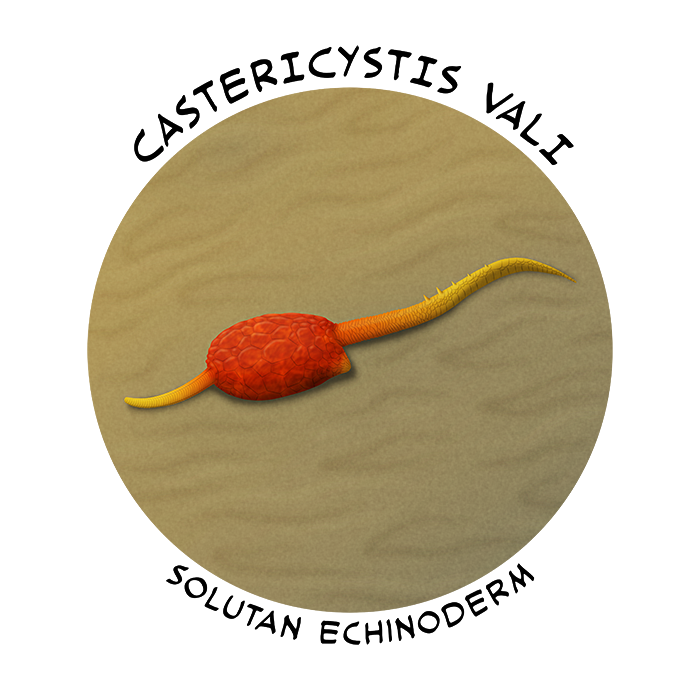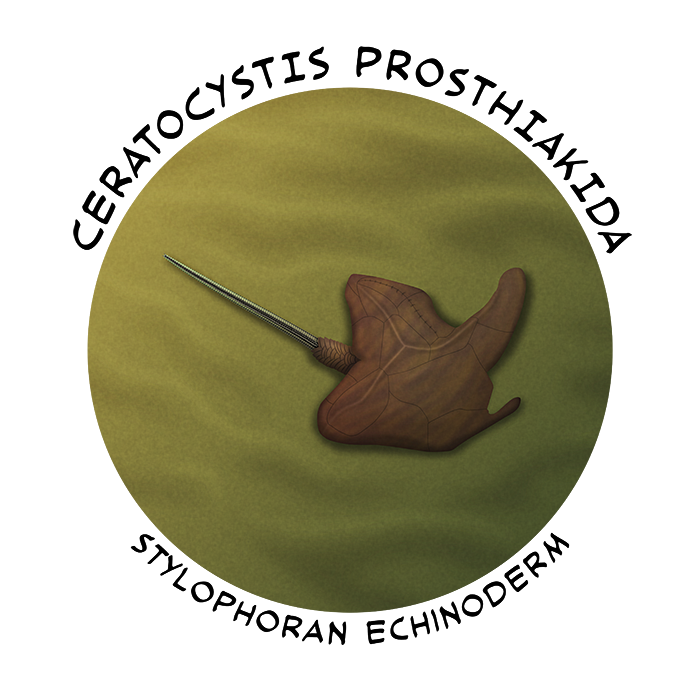During their early evolution, echinoderms started developing unusual asymmetric body plans – and some of them were so strange-looking that for a while it wasn’t clear if they even were echinoderms.
A group called solutes were superficially bilateral in appearance, with a feeding arm at the “front” and a long tail-like appendage at the “back”. But their bodies didn’t really have any true axis of symmetry, slightly irregularly shaped and with the “arm” offset to one side.
The ancestors of this lineage probably branched off from a common ancestor with modern echinoderms shortly after the cinctans, and they seem to have been suspension-feeding animals that lived attached to the seafloor via stem-like appendages. But fairly early on in their evolution they instead switched to a mobile free-living mode of life, modifying their stalks into “tails” used to push themselves along.

Castericystis vali was one of the earliest know solutes, found in the Marjum Formation in Utah, USA (~505 million years ago). Growing up to about 8cm long, it seems to have been transitional between attached and free-living, with juveniles temporarily attaching themselves to surfaces – sometimes even being found stuck onto the “tails” of other individuals of their own species.
The stylophorans, meanwhile, pushed an asymmetrical body plan to an even bigger extreme. All members of this group had an irregularly-shaped body and a single feeding arm, but their forms could vary wildly – early species were bizarrely “boot-shaped”, while others returned to an almost-bilateral shape.
For a long time it was uncertain which end of their bodies was which, or what sort of animal they even were – they were generally considered to be a weird group of echinoderms based on their calcite skeleton, but some studies instead considered them to be early ambulacrarians or even early chordates. Their echinoderm affinities were only actually fully confirmed in 2019 with the discovery of fossils with preserved soft tissue impressions, including distinctive echinoderm tube feet on their appendages.
But their exact position within the echinoderm evolutionary tree is still rather uncertain. They may be stem-echinoderms related to the solutes, or they might be close relatives of blastozoans or crinoids which secondarily lost their radial symmetry and convergently developed a similarly asymmetrical body plan.

Ceratocystis prosthiakida was one of the earliest known stylophorans, living about 510 million years ago in southeast Germany. Just 2.5cm long (1″), it had a wide flat boot-shaped body with a prominent three-way ridge on its upper surface. It would have been able to move itself across the seafloor using its feeding arm, although the motion would have been “backwards” relative to the orientation of its body.
The odd shapes of stylophorans like Ceratocystis was probably an adaptation to living on very soft sediments – an increased surface area spreading out their weight to act like a snowshoe, and highly exaggerating their asymmetry in the process. Later more symmetrical forms may have instead been adapted for streamlining and stability in areas with strong water currents.
Despite their sometimes awkward appearances both of these weird echinoderm groups were surprisingly successful after the Cambrian. Solutes became widespread during the Ordovician and lasted until the early Devonian (~400 million years ago), while stylophorans continued all the way until the late Carboniferous (~310 million years ago).
